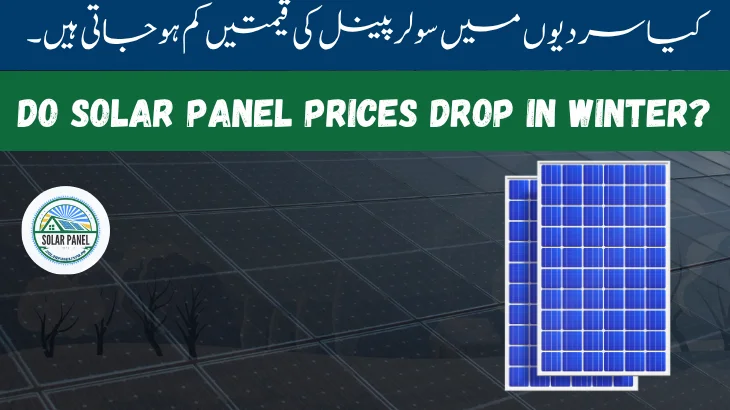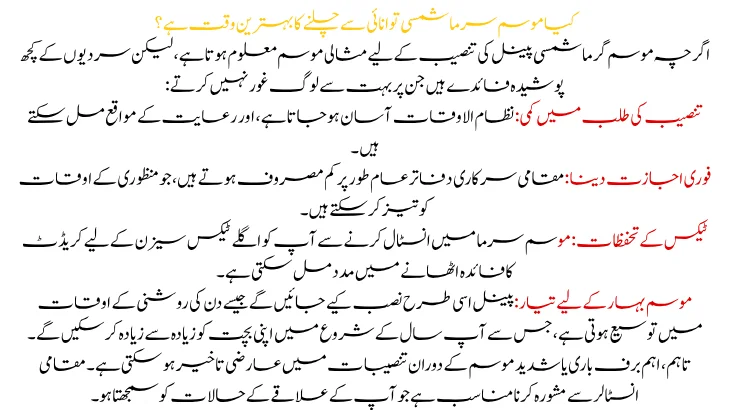Do Solar Panel Prices Drop in Winter? Seasonal Market Trends Explained
As solar energy gains popularity, many are curious about solar panel price trends, particularly whether prices drop in winter. Seasonal factors like decreased demand and installation during colder months can lead some suppliers to offer discounts. However, prices are also affected by global supply chains, local policies, and currency fluctuations. This article will explore how these seasonal market patterns impact solar panel costs and assess whether winter is indeed the best time to invest in solar energy.
Read Also: Solar Panel Performance vs Weather Conditions

جیسے جیسے شمسی توانائی کی مقبولیت بڑھ رہی ہے، بہت سے لوگ شمسی پینل کی قیمت کے رجحانات کے بارے میں متجسس ہیں، خاص طور پر کہ آیا موسم سرما میں قیمتیں کم ہوتی ہیں۔ موسمی عوامل جیسے سرد مہینوں میں مانگ میں کمی اور تنصیب کچھ سپلائرز کو رعایت کی پیشکش کر سکتی ہے۔ تاہم، قیمتیں عالمی سپلائی چینز، مقامی پالیسیوں اور کرنسی کے اتار چڑھاو سے بھی متاثر ہوتی ہیں۔ یہ مضمون دریافت کرے گا کہ یہ موسمی مارکیٹ کے پیٹرن کس طرح شمسی پینل کی لاگت کو متاثر کرتے ہیں اور اس بات کا جائزہ لیں گے کہ آیا واقعی موسم سرما شمسی توانائی میں سرمایہ کاری کرنے کا بہترین وقت ہے۔
Winter’s Impact on Solar Panel Prices: Key Market Factors
- Seasonal Demand: Winter generally sees lower demand for solar installations due to less favorable weather conditions, leading to potential price dips as installers seek to attract customers.
- Supply Dynamics: An oversupply of solar modules can drive prices down, while supply constraints from reduced imports may lead to price increases.
- Installer Offers: In winter, installers may provide bundled deals (e.g., free maintenance, lower labor costs) to incentivize purchases, which can lower overall system costs despite panel prices remaining stable.
- Installation Complexity: Cold weather can complicate installations due to snow and shorter days, potentially increasing labor costs and offsetting price advantages.
- Panel Efficiency: While solar panels operate more efficiently in cooler temperatures, price is primarily affected by market supply and demand rather than physical performance.
What global trends say about solar panel pricing
- Global module prices for solar panels have been declining, reaching an all-time low in 2024 due to oversupply in major manufacturing regions.
- Seasonal effects may intensify when market conditions favor low prices, with prices expected to remain low for up to two years.
- Exchange rates, import duties, and tariffs significantly impact prices, as seen in markets like Pakistan, where currency appreciation led to price reductions.
- While there is a current downward trend, experts caution that prices may stabilize or increase as inventories decrease and demand rises, particularly in import-heavy markets.
Seasonal Solar Pricing in Pakistan
- In Pakistan, particularly in Pir Jo Goth, Sindh, solar panel prices tend to decrease before summer or during low-demand seasons.
- As of September–October 2025, prices fell sharply to Rs. 25-37 per watt, a 25%-40% decline.
- Winter is often a better time for purchases due to lower demand, logistical difficulties, and potential discounts from installers.
- Local advice suggests planning purchases before peak summer or during off-season months for better rates.
- However, winter doesn’t guarantee the lowest prices, as a drop in imports can lead to price increases, and costs for components like inverters and batteries may not decrease similarly.
Key factors that influence solar panel price (beyond seasonality)
- Raw Materials & Manufacturing Costs: Prices are impacted by the cost of silicon, glass, and metals, with mass production contributing to lower costs over time.
- Supply Chain & Logistics: Shipping costs, import duties, currency exchange rates, and inventory levels significantly affect prices, particularly in markets reliant on imports.
- Demand Fluctuations: Seasonal trends and changes in residential vs. commercial installation demand can lead to price hikes, especially during peak times like summer. Government policies can also influence demand.
- Installation Costs: Installation costs vary by location and season, while ancillary component prices may not decrease proportionally with panel prices.
- Policies and Incentives: Tariffs, subsidies, and local regulations impact final costs significantly, with changing policies affecting market dynamics.
- Seasonal Conditions: Weather and installation conditions affect demand and labor costs, with winter installs potentially slower and more costly.
- Government Incentives: Tax credits and rebates can substantially lower costs, but changes in these incentives can lead to demand fluctuations.
- Technological Advancements: Innovations in solar technology can gradually lower prices over time.
- Energy Prices and Inflation: Rising electricity rates can increase solar demand, affecting prices, while stabilization may lead to better deals during off-peak periods.
Should you wait for winter to buy? Pros & Cons
Pros of buying solar in winter
- Potential for better pricing from installers during slower months.
- More opportunity to compare quotes and gather offers.
- Favourable panel pricing if supply is strong.
- Being ready for higher-demand seasons (spring/summer).
Cons to consider
- Lower solar output in regions with short winter days.
- Potentially higher costs or longer installation times due to harsh weather.
- Risk of missing incentives or optimal installation conditions.
- Price increases if supply tightens later.
Is Winter the Best Time to Go Solar?
Although summer may appear to be the ideal season for solar panel installation, winter has some hidden benefits that many people do not consider:
- Decreased installation demand: Scheduling becomes easier, and there may be opportunities for discounts.
- Quicker permitting: Local government offices are usually less busy, which can accelerate approval times.
Read Also: Performance and Reliability Analysis of Inverters

- Tax considerations: Installing in winter can help you take advantage of credits for the next tax season.
- Prepared for spring: The panels will be installed just as daylight hours expand, allowing you to maximize your savings early in the year.
However, installations during significant snowfall or severe weather might experience temporary delays. It’s advisable to consult with a local installer who understands the conditions in your area.
How to time your purchase: Practical tips
- Monitor Local Panel Prices: Keep track of per-watt prices and changes in imported panel costs due to exchange rates.
- Get Multiple Quotes in the Off-Season: Approach several installers during slower months to compare panel brands, warranties, and prices.
- Check Inventory and Supply Arrival: Inquire about shipping timelines; new shipments may lead to better deals.
- Consider Installation Scheduling: Buy panels in winter but schedule installation for early spring to maximize daylight and improve weather conditions.
- Factor in Full System Cost: Remember that panels are only part of the total cost; consider inverters, batteries, and installation expenses.
- Check Policies and Incentives: Be aware of net-metering rules and any potential changes in electricity tariffs or incentives that could impact costs.
- Decide Based on Electricity Usage: If peak usage occurs in summer, prioritize installation before the season; otherwise, wait for better pricing.
Conclusion
In conclusion, while prices for solar panels usually decrease in winter due to reduced demand and promotions from installers, a variety of other elements—such as import volumes, exchange rates, and government regulations—also impact final pricing. In areas like Pakistan, particularly Sindh, winter can be an advantageous time to purchase, as many installers provide discounts prior to the busy summer months. However, delaying a decision could be detrimental if imports decline or incentives shift. The most effective strategy is to keep an eye on local market trends, evaluate different quotes, and plan in advance to secure both a favorable price and a timely installation.
آخر میں، جب کہ سولر پینلز کی قیمتیں عموماً سردیوں میں کم ہوتی ہیں جس کی وجہ سے انسٹالرز کی مانگ اور پروموشنز کم ہوتی ہیں، مختلف قسم کے دیگر عناصر جیسے کہ درآمدی حجم، شرح مبادلہ، اور حکومتی ضوابط بھی حتمی قیمتوں کو متاثر کرتے ہیں۔ پاکستان، خاص طور پر سندھ جیسے علاقوں میں، موسم سرما خریداری کے لیے ایک فائدہ مند وقت ہو سکتا ہے، کیونکہ بہت سے انسٹالرز گرمیوں کے مصروف مہینوں سے پہلے چھوٹ فراہم کرتے ہیں۔ تاہم، اگر درآمدات میں کمی یا مراعات میں تبدیلی آتی ہے تو فیصلے میں تاخیر نقصان دہ ہو سکتی ہے۔ سب سے مؤثر حکمت عملی یہ ہے کہ مقامی مارکیٹ کے رجحانات پر نظر رکھیں، مختلف حوالوں کا جائزہ لیں، اور مناسب قیمت اور بروقت تنصیب دونوں کو محفوظ بنانے کے لیے پیشگی منصوبہ بندی کریں۔
FAQs
Do solar panel prices always drop in winter?
Not always. While lower demand can lead to temporary price reductions, supply issues or currency fluctuations may offset those drops.
Is winter a good time to install solar panels in Pakistan?
Winter is a good time for purchasing installations due to discounts, but they should be completed before summer for optimal energy output.
What factors affect solar panel prices the most?
Key factors include global supply and demand, import costs, currency exchange rates, government incentives, and local installation costs..


